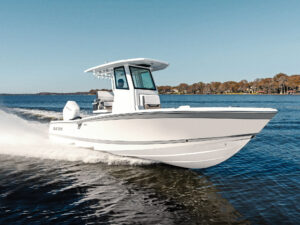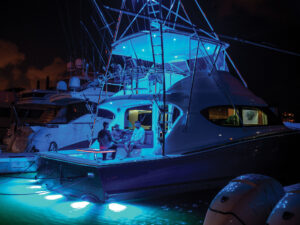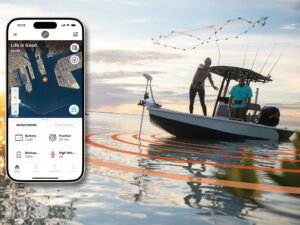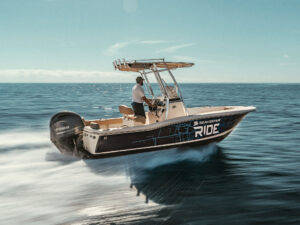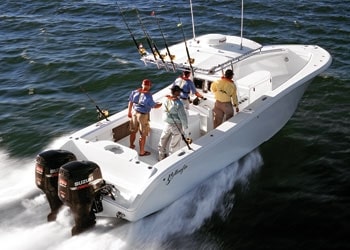
From smart phones and cameras to entertainment systems, the digital age is changing the way we work and play. The same holds true for boating. Every month my colleague, Glenn Law, describes in his column how marine electronics are going digital faster than a Pentium chip.
But the impact doesn’t end there. High horsepower outboards with computerized control modules maximize performance and fuel efficiency. Networking capability between the gauges and components lets the operator monitor various functions. Digital technology is also rapidly shifting, literally, to the helm. Mercury, Suzuki and Yamaha all now offer electronic “fly-by-wire” engine throttle controls on select outboard models. The advantages of using data rather than cable are numerous.
“With digital controls, there’s no cable binding or play, so the operator has smooth, positive shifting at all times and precise throttle response, especially at low rpm levels,” says Gus Blakely, a sales manager with Suzuki Outboards. “It’s as close to clunk-free shifting as you can get.”
Rig Faster and Easier
Initial rigging time is greatly reduced with digital controls because of the single wiring harness. That simplicity makes it easier to connect multiple engines or add secondary control stations. After installation, digital throttles are virtually maintenance-free. Waterproof connectors and the absence of mechanical cables minimize corrosion. Best of all, users can adjust throttle friction levels and other settings based on personal preference.
“Once someone switches over to digital, they’ll never go back to standard controls,” says Blakely. “The only reason we haven’t gone totally digital is the price. As electronic components get cheaper, I expect we’ll see greater integration throughout the industry.”
Mercury Outboards offers the most applications for its digital throttle and shift (DTS) system. The Verado line of four-stroke engines – from 135- up to 350-horsepower – are all DTS-ready. So are two mid-range OptiMax direct-injection models. For each, the controls are integrated within their proprietary SmartCraft system.
“Ours is truly a complete integration,” says Ben Duke, the product line manager for SmartCraft. “It starts with our proprietary controlled area network (CAN), which is different from the NMEA protocol. We also build every part of the system ourselves, from the propellers to the engine, gear box, wiring harnesses and controls.
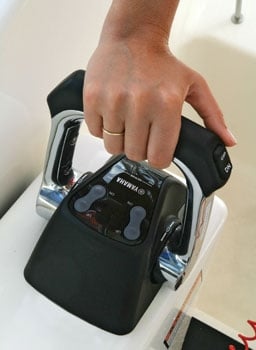
“DTS is a new twist on a classic piece of boating equipment,” Duke adds. “It’s a very robust system. We put it through 900 hours of saltwater exposure and UV testing, followed by more tests at Sandia National Laboratory for safety and reliability before the initial release. End users love DTS. It represents a real change that ultimately means more boating and less work.”
Yamaha’s Command Link digital electronic controls, introduced on the F350 V-8 four-stroke, are safety oriented, as well. The connecting harness has three wires for redundancy. Two wires connect to each sensor, so if one fails, the signals still transmit on the other. Each engine has a separate control-box module.
“We try to build as much safety as possible into the system,” says Dave Wheeler, the product information manager for Yamaha Outboards. “Command Link is based on NMEA 2000 protocol, so it’s been thoroughly tested. If communication is lost, you can still take the engine cowling off and manually override the shift using a No. 2 screwdriver. So you always have get-home capability,” he explains.
Angling Advantages
Individual differences aside, there are several features common to all three manufacturers’ digital throttle systems that are practical for anglers. With twin or triple engines, the computers will maintain a constant rpm level using a built-in synchronizer, so you don’t have to bump one throttle lever to match the other. The synchronizer function can be manually overridden, however.
In a triple-engine application, all three engines can be controlled using only two throttle levers. The center outboard follows one of the outside engines in normal operating conditions. When the need for low-speed maneuvering arises, like in docking or loading the boat on the trailer, the center engine can be turned off or switched to idle. Mercury’s docking mode gives a choice of 50-percent power reduction while maintaining full throw of the throttles. “That lets you tame the beast at the dock,” Duke explains.
Trolling mode is another practical function available with digital controls. With this option selected, the engines can be fine-tuned in small rpm increments to set and maintain the optimum trolling speed.
Due to the single, color-coded wiring harness, installing a secondary station in a tower or cockpit is simply a matter of routing the extra harness for “plug-and-play” simplicity. Suzuki made their installation even more foolproof by using the same connectors on both ends of the harness. Bottom line: Because digital controls take less time to install, the consumer saves money on the labor bill.
But new technology doesn’t come cheap. Digital controls cost more than the mechanical ones they replace. The additional charge can run as high as $1,500. With some engines, like Yamaha’s F350, for example, digital controls are required, so the cost is built into the retail price.
Consider this, though: Those original, clunky cellular phones you had to lug around in a tote bag were pricey when they first came out. But it didn’t take long before demand shrank both the size and price. The same thing will happen with digital throttles. Only this time, it won’t take as long.
Harnessing the Horses
Digital control throttles are not the only accessories unique to big block outboards. Because of their heavier weight and the extra torque generated, special modifications are required for the steering systems. Mercury developed an electro-hydraulic power steering setup for the Verados. Similar to a car, it uses an electric pump with a hydraulic steering cylinder to reduce torque and fatigue.
Suzuki and Yamaha relied on existing after-market products. Teleflex Marine (teleflexmarine.com), makers of SeaStar hydraulic steering systems, beefed up cylinders and added a power-assist pump to counter the extra weight and torque.
Latham Marine (lathammarine.com) builds another option specifically for the Yamaha F350 V-8 engine. Its side-mount stainless-steel bracket ties into the power head so the entire engine turns instead of pivoting on a center-mount connecting pin.
The Players
Mercury DTS System
Verado Four-Strokes
135 to 350 hp
OptiMax DI Engines
200 and 225 hp
www.mercurymarine.com
Suzuki Precision Control
DF300 Four-Stroke
www.suzukimarine.com
Yamaha Command Link
Digital Electronic Controls
F250, F300 and F350 Four-Strokes
www.yamahaoutboards.com

